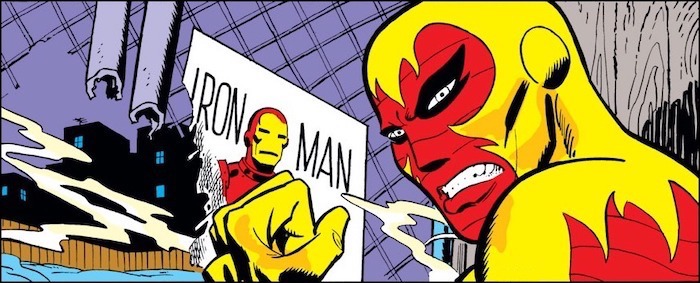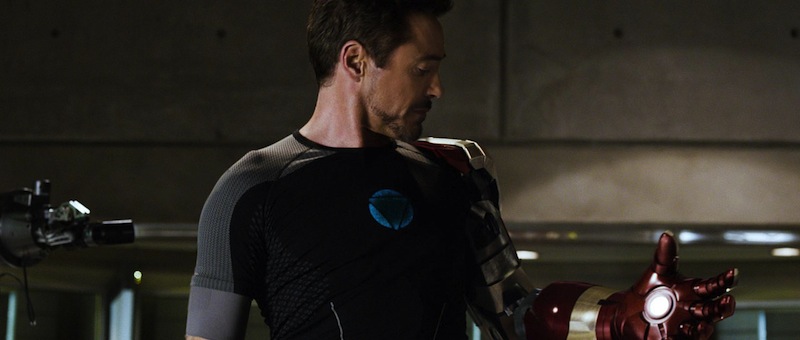I found Iron Man 3 a fine kickoff to what Marvel Studios is calling Phase Two of the Marvel Cinematic Universe — Phase One having culminated in the assemblage of nearly every superhero thus far introduced to the MCU in 2012’s The Avengers.

Given that it builds deliberately on what’s come before, Iron Man 3 isn’t an optimal entry to the series; a familiarity with the characters and their milieu is recommended.
If you’ve enjoyed the previous films, however, Robert Downey Jr.’s Tony Stark in particular, grab a ticket. For darn sure it’s better than 2010’s Iron Man 2, although certain flaws of that movie are revisited. The way in which 3 gets to jump straight into its world, history established, might even make it more fun than 2008’s original. In that regard (and in some aspects of the plot) it’s not unlike an installment of the Bond franchise, a parallel driven home at the very end and made explicit too in press interviews by co-writer/director Shane Black.
So there’s a quickie assessment. I’ll add spoiler commentary after the next graphic.
Join me below if/when you’ve seen Iron Man 3 or just don’t care...

Panel from digital edition of Iron Man #48 © 1974 Marvel. Pencils: George Tuska.
Inks: Vince Colletta. Letters: John Costanza. Colors: Unknown. Editing: Stan Lee.
An early comic book of mine, Iron Man #48, featured an antagonist called Firebrand. He possessed flame powers and his outfit looked intriguingly like Iron Man’s with the color scheme reversed. I haven’t read the 2005-2006 “Extremis” storyline, on which much of Iron Man 3 was based, so I wondered if the enhanced strength and incendiary abilities of the villains in the film weren’t the MCU’s take on that character.

Cover to digital edition of the second appearance of Firebrand, Iron
Man #48, © 1974 Marvel. Pencils: Gil Kane. Inks: Vince Colletta.
Letters: John Costanza. Colors: Unknown. Editing: Stan Lee.
My hope was that Gwyneth Paltrow’s Pepper Potts, upon surviving Extremis, would adopt the alter ego of Firebrand in the kind of twist on the comics that Marvel’s brain trust has shown it isn’t afraid to offer. The MCU could use more women of power — actual, physical power, not just (the nonetheless welcome) prowess in verbal sparring and business smarts. Having Pepper’s Extremis infection neutralized if not removed outright in the epilogue suggests otherwise, yet doesn’t entirely close the door on it.
I was glad Pepper emerged from her apparent demise to join the fray. After the attack on Stark’s home earlier in the film, which found her wearing the armor herself and saving Tony, she was all too obviously, all too tritely the damsel in distress during the climax. You can of course rationalize that as her being the plain ol’ normal person and him being the superhero as opposed to her being the woman and him being the man — especially because the injections of nanites or whatever that allowed Tony to control the armor even when he wasn’t wearing it afforded him an innate superpower as long as there was Iron Man tech around — but you’d also think, in the wake of everything that’s gone down since Iron Man 1, that she’d have had some training in self-defense.

Stills from Iron Man 3 © 2013 and characters TM/® Marvel.
That need for self-defense nags at me.
I understood why the filmmakers had Tony admit he was Iron Man at the end of the first movie, yet the decision only replaced one set of storytelling problems with another. Iron Man 2 touched on the obvious peril he’d be in without a secret identity, but it’s not as if the issue has been dealt with come Iron Man 3.
Giving out his home address on television would be a monumentally stupid act of hubris on Tony’s part — if people had not previously known where he lived, which the film seems to be implying and which I don’t believe for a second. His place isn’t so remote that it doesn’t have a street number. Moreover, Tony is such a celebrity as a billionaire genius playboy superhero that surely the media has camped out on his doorstep before whether at Stark Tower in New York or in Malibu or any other place he’s so much as rumored to have been spotted. We don’t get even a hint that the house has a force field on the perimeter or holographic stealth camouflage or automated defense weaponry, making the assault by the forces of the supposed Mandarin, sent by Guy Pearce’s Aldritch Killian, a giant case of You mean this has never happened before?

Cover to digital edition of the first appearance of The Mandarin, Tales of
Suspense #50, © 1963 Marvel. Pencils: Jack Kirby. Inks: George Roussos.
Letters: Artie Simek. Colors: Stan Goldberg. Editing: Stan Lee.
I appreciated seeing Tony go into action mode without the suit, both in terms of reminding us that the real power behind the Iron Man armor is Tony Stark’s ingenuity and (to echo some of the criticism above) in terms of showing us that Tony has cultivated a degree of skill in armorless combat. That skill disappears the moment he teams up with Don Cheadle’s Jim Rhodes, and I’m not sure why Stark wouldn’t need a bodyguard now more than ever given his frequent recklessness, be it Happy Hogan or the artificial intelligence JARVIS in a hollow Iron Man suit; Black and co-writer Drew Pearce have made a far less uneven film than Iron Man 2, though, so I should be thankful for that.

Panel from digital edition of Tales of Suspense #50 © 1963 Marvel. Script, Editing:
Stan Lee. Pencils, Inks: Don Heck. Letters: Ray Holloway. Colors: Unknown.
Other aspects of the movie left me similarly hot and cold at various points. Tony’s anxiety over the events in last year’s Avengers made perfect sense, particularly given how the Marvel films have adapted their source material’s trademark of heroes with hang-ups, despite feeling a bit simplistic. It helped explain why no effort was made by Tony to contact another member of the group for good measure, as did his physical isolation, but scenes of the government trying to get Captain America and/or Nick Fury and SHIELD involved were still warranted.
While the finale got overly frantic in spots, it had a certain welcome rhythm. I might
not quite buy Tony leaping through the air into an Iron Man suit from behind without getting pancaked; on the other hand, it’s a testament to Downey and Black (and Jon Favreau before him) that I totally buy Tony’s literal leaps of faith in terms of character. Downey’s completely unsentimental dialogue likewise saves Tony’s scenes with the kid in Tennessee, a crucial plot strand that could easily have been cloying. The approach to Ben Kingsley’s Mandarin was also brilliant as written and delivered, however much I’d have loved to see the character’s comic-book persona translated successfully to the screen in full supervillain mode. I remain at a loss as to why a movie released the first week in May was set so distractingly at Christmastime with no narrative payoff that couldn’t have been easily reworked.

“Tony Stark will return,” we’re told, Bond-style, during the end credits following a choice title sequence whose valedictory flavor tasted more final than forward-looking. I’ll keep my fingers crossed that Downey, his contractual obligations to Marvel now complete, will at least pop up in future Avengers installments and perhaps be a guiding force in further Iron Man films as mentor, tinker, and not-too-silent partner to Rhodey or anyone else who might succeed him in the suit. Until we get a wholesale reboot of the Marvel Cinematic Universe, which shouldn’t yet even be a glint in producer Kevin Feige’s eye, I can’t see a new actor stepping into Stark’s boots.
Iron Man 3 was both entertaining and substantive enough that my enthusiasm for the rest of MCU Phase Two is barely in check. The next Thor arrives in November, with Captain America: The Winter Soldier and wild card Guardians of the Galaxy coming next year. I can hardly wait.
How about you?
Related: The A Team • One Flash, Two Flash, Red and Blue Flash • Get Carter Back

No comments:
Post a Comment